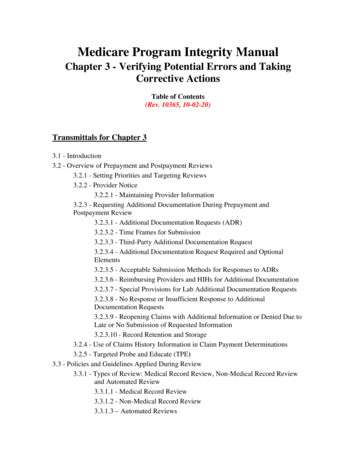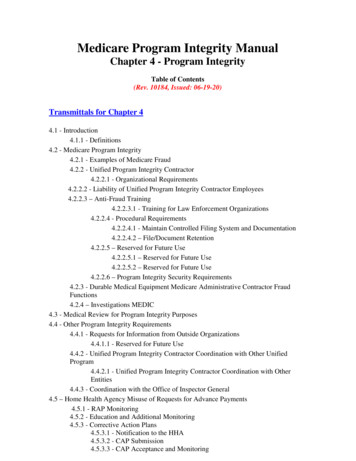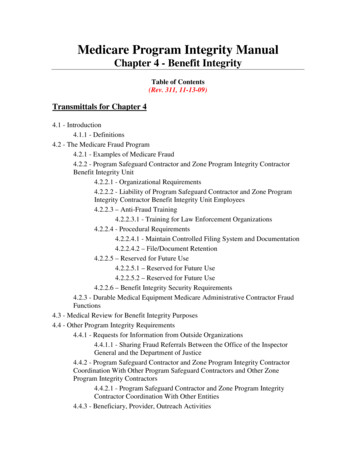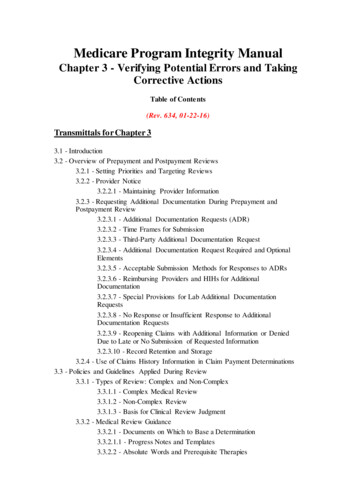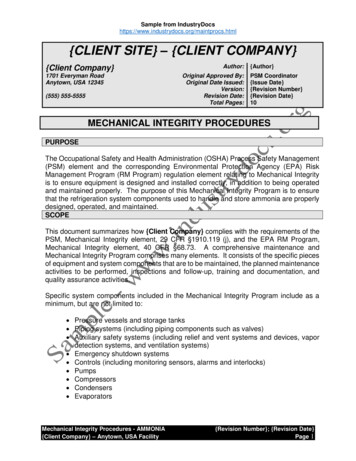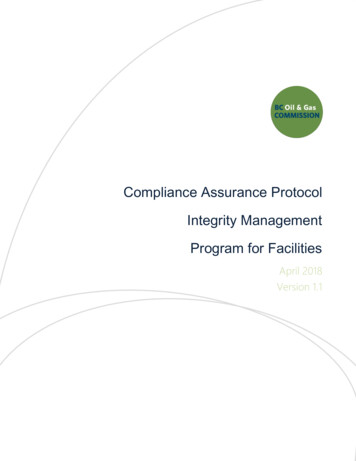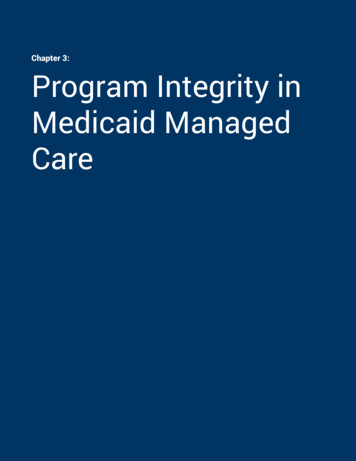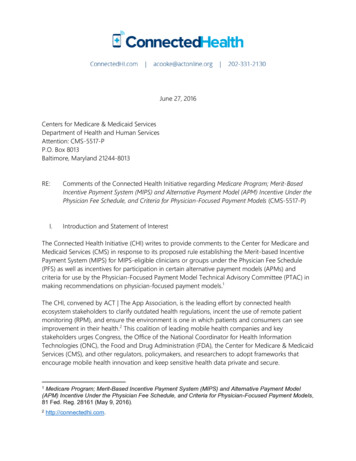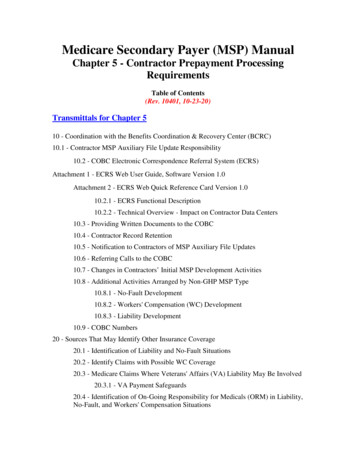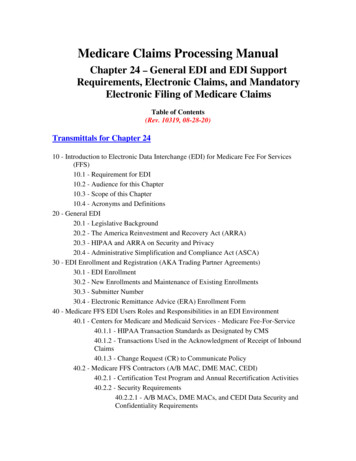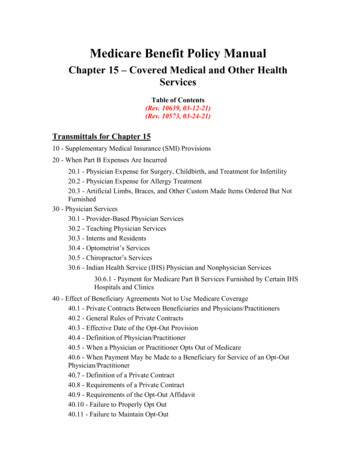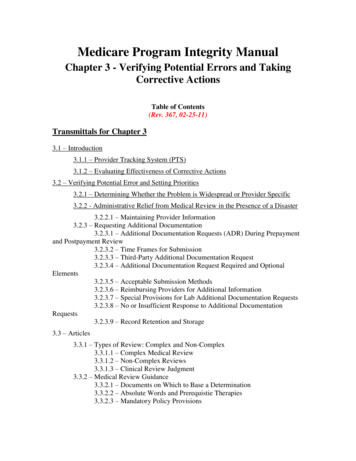
Transcription
Medicare Program Integrity ManualChapter 3 - Verifying Potential Errors and TakingCorrective ActionsTable of Contents(Rev. 367, 02-25-11)Transmittals for Chapter 33.1 – Introduction3.1.1 – Provider Tracking System (PTS)3.1.2 – Evaluating Effectiveness of Corrective Actions3.2 – Verifying Potential Error and Setting Priorities3.2.1 – Determining Whether the Problem is Widespread or Provider Specific3.2.2 - Administrative Relief from Medical Review in the Presence of a Disaster3.2.2.1 – Maintaining Provider Information3.2.3 – Requesting Additional Documentation3.2.3.1 – Additional Documentation Requests (ADR) During Prepaymentand Postpayment Review3.2.3.2 – Time Frames for Submission3.2.3.3 – Third-Party Additional Documentation Request3.2.3.4 – Additional Documentation Request Required and OptionalElements3.2.3.5 – Acceptable Submission Methods3.2.3.6 – Reimbursing Providers for Additional Information3.2.3.7 – Special Provisions for Lab Additional Documentation Requests3.2.3.8 – No or Insufficient Response to Additional DocumentationRequests3.2.3.9 – Record Retention and Storage3.3 – Articles3.3.1 – Types of Review: Complex and Non-Complex3.3.1.1 – Complex Medical Review3.3.1.2 – Non-Complex Reviews3.3.1.3 – Clinical Review Judgment3.3.2 – Medical Review Guidance3.3.2.1 – Documents on Which to Base a Determination3.3.2.2 – Absolute Words and Prerequistie Therapies3.3.2.3 – Mandatory Policy Provisions
3.3.2.4 – Signature Requirements3.3.2.5 – Late Entries in Medical Documentation3.3.2.6 – Psychotherapy Notes3.3.2.7 –Review Guidelines for Therapy Services3.3.2.8 – MAC Articles3.3.3 – Reviewing Claims in the Absence of Policies and Guidelines3.4 - Overview of Prepayment and Postpayment Review for MR Purposes3.4.1 – Determinations Made During Prepayment and Postpayment MR3.4.1.1 - Documentation Specifications for Areas Selected for Prepaymentor Postpayment MR3.4.1.1.1 - Exception From the Uniform Dollar Limitation (“TherapyCap”)3.4.1.2 – Additional Documentation Requests (ADR) During Prepaymentor Postpayment MR3.4.1.3 – Completing Complex Reviews3.4.1.4– Handling Late Documentation3.4.1.5 - Reopenings of Claims Denied Due to Failure to Submit NecessaryMedical Documentation (remittance advice code N102 or 56900)3.4.2 – Medical Review Denial Notices3.4.2.1 - Role of Conditions of Participation Requirements When Makinga Payment Decision3.4.3 – Documenting That A Claim Should Be Denied3.4.4 – Internal MR Guidelines3.4.5 – Types of Prepayment and Postpayment Review3.4.6 - Spreading Workload Evenly3.4.7 - New Provider / New Benefit Monitoring3.4.8 - Review That Involves Utilization Parameters3.5 – Prepayment Review of Claims For MR Purposes3.5.1 – Automated Prepayment Review3.5.1.1 – Prepayment Edits3.5.2 – Categories of MR Edits3.5.3 – CMS Mandated Edits3.5.4 – Non-random Prepayment Complex Medical Review3.6 – Postpayment Review of Claims For MR Purposes3.6.1 – Postpayment Review Case Selection3.6.2 – Location of Postpayment Reviews
3.6.2.1 – Coverage Determinations3.6.2.2 – Reasonable and Necessary Criteria3.6.2.3 – Limitation of Liability Determinations3.6.2.4 – Coding Determinations3.6.2.5 – Denial Types3.6.3 – Re-adjudication of Claims3.6.4 – Calculation of the Correct Payment Amount and SubsequentOver/Underpayment3.6.5 – Notification of Provider(s) or Supplier(s) and Beneficiaries of thePostpayment Review Results3.6.6 – Provider(s) or Supplier(s) Rebuttal(s) of Findings3.6.7 – Referral of Overpayments3.6.8 – Evaluation of the Effectiveness of Postpayment Review and Next Steps3.6.9 – Postpayment Files3.7 – Appeal of Denials3.7.1 – Progressive Correction Action (PCA)3.7.1.1 – Provider Error Rate3.7.1.2 – Vignettes3.7.1.3 – Provider Notification and Feedback3.7.2 – Comparative Billing Reports (CBRs)3.7.3 – Evaluating the Effectiveness of Corrective Actions3.7.3.1 – Evaluation of Prepayment Edits3.7.3.2 – Evaluating Effectiveness of Established Automated Edits3.7.3.3 – Evaluation of Postpayment Review Effectiveness3.7.4 – Tracking Appeals3.8 – Overpayment Procedures3.8.1 – Overpayment Assessment Procedures3.8.1.1 – Definition of Overpayment Assessment Terms3.8.2 – Assessing Overpayment When Review Was Based on Statistical Samplingfor Overpayment Estimation3.8.3 – Assessing Overpayment or Potential Overpayment When Review WasBased on Limited Sample or Limited Statistical Sampling for Overpayment EstimationSub–sample3.8.3.1 – Contractor Activities to Support Assessing Overpayment3.8.3.2 – Conduct of Expanded Review Based on Statistical Sampling forOverpayment Estimation and Recoupment of Projected Overpayment by Contractors3.8.3.3 - Consent Settlement Instructions3.8.3.3.1 - Background on Consent Settlement
3.8.3.3.2 - Opportunity to Submit Additional Information BeforeConsent Settlement Offer3.8.3.3.3 - Consent Settlement Offer3.8.3.3.4 - Option 1 - Election to Proceed to Statistical Samplingfor Overpayment Estimation3.8.3.3.5 - Option 2 - Acceptance of Consent Settlement Offer3.8.3.3.6 - Consent Settlement Budget and PerformanceRequirements for ACs3.8.4 – Coordination with Aduit and Reimbursement Staff3.9 – Suspension of Payment3.9.1 – When Suspension of Payment May Be Used3.9.1.1 – Fraud or Willful Misrepresentation Exists – Fraud Suspensions3.9.1.2 – Overpayment Exists But the Amount is Not Determined –General Suspensions3.9.1.3 – Payments to be Made May Not be Correct – GeneralSuspensions3.9.1.4 – Provider Fails to Furnish Records and Other RequestedInformation – General Suspensions3.9.2 – Procedures for Implementing Suspension of Payment3.9.2.1 – CMS Approval3.9.2.2 – The Notice of Intent to Suspend3.9.2.2.1 – Prior Notice Versus Concurrent Notice3.9.2.2.2 – Content of Notice3.9.2.2.3 – Shortening the Notice Period for Cause3.9.2.2.4 – Mailing the Notice to the Provider3.9.2.2.5 – Opportunity for Rebuttal3.9.2.3 – Claims Review During the Suspension Period3.9.2.3.1 – Claims Review3.9.2.3.2 – Case Development - Benefit Integrity3.9.2.4 – Duration of Suspension of Payment3.9.2.5 – Removing the Suspension3.9.2.6 – Disposition of the Suspension3.9.2.7 – Contractor Suspects Additional Improper Claims3.9.3 – Suspension Process for Multi–Region Issues
3.9.3.1 – DME MACs, DME PSCs, and ZPICS3.9.3.2 – Reserved for Future Use3.10 – Use of Statistical Sampling for Overpayment Estimation3.10.1 – Introduction3.10.1.1 – General Purpose3.10.1.2 - The Purpose of Statistical Sampling3.10.1.3 – Steps for Conducting Statistical Sampling3.10.1.4 - Determining When Statistical Sampling May be Used3.10.1.5 – Consultation With a Statistical Expert3.10.1.6 – Use of Other Sampling Methodologies3.10.2 – Probability Sampling3.10.3 – Selection of Period to be Reviewed and Composition of Universe3.10.3.1 – Selection of Period for Review3.10.3.2 – Defining the Universe, the Sampling Unit, and the SamplingFrame3.10.3.2.1 – Composition of the Universe3.10.3.2.2 – The Sampling Unit3.10.3.2.3 – The Sampling Frame3.10.4 – Sample Selection3.10.4.1 – Sample Design3.10.4.1.1 – Simple Random Sampling3.10.4.1.2 – Systematic Sampling3.10.4.1.3 – Stratified Sampling3.10.4.1.4 – Cluster Sampling3.10.4.1.5 – Design Combinations3.10.4.2 – Random Number Selection3.10.4.3 – Determining Sample Size3.10.4.4 – Documentation of Sampling Methodology3.10.4.4.1 – Documentation of Universe and Frame3.10.4.4.2 – Arrangement and Control Totals3.10.4.4.3 – Worksheets3.10.4.4.4 – Overpayment/Underpayment Worksheets
3.10.4.5 – Informational Copies to Primary GTL, Associate GTL, SME orCMS RO3.10.5 – Calculating the Estimated Overpayment3.10.5.1 – The Point Estimate3.10.5.2 – Calculation of the Estimated Overpayment Amount3.10.6 – Actions to be Performed Following Selection of Provider or Supplier andSample3.10.6.1 – Notification of Provider or Supplier of the Review and Selectionof the Review Site3.10.6.1.1 – Written Notification of Review3.10.6.1.2 – Determining Review Site3.10.6.2 – Meetings to Start and End the Review3.10.6.3 – Conducting the Review3.10.7- Overpayment Recovery3.10.7.1 – Recovery from Provider or Supplier3.10.7.2 – Informational Copy to Primary GTL, Associate GTL, SME orCMS RO3.10.8 – Corrective Actions3.10.9 – Changes Resulting from Appeals3.10.9.1 – Sampling Methodology Overturned3.10.9.2 – Revised Initial Determination3.10.10 – Resources3.10.11 – Additional Discussion of Stratified Sampling and ClusterSampling3.10.11.1 – Stratified Sampling3.10.11.2 – Cluster Sampling3.11 - Progressive Corrective Action (PCA)3.11.1 - General Information3.11.1.1 - Review of Data3.11.1.2 - “Probe” Reviews3.11.1.3 - Target Medical Review Activities3.11.1.4 - Requesting Additional Documentation3.11.1.5 - Provider Error Rate3.11.1.6 - Provider Notification and Feedback
3.11.1.7 - Overpayments3.11.1.8 - Fraud3.11.1.9 - Track Interventions3.11.1.10 - Track Appeals3.11.2 - Implementation3.11.3 - Vignettes3.12 - MR High Risk3.13 – Prior Determination Process3.14 – Clinical Review Judgment3.15 - Advanced Beneficiary Notice (ABN) and Complex Medical Record Review3.17 – Corrective Action Reporting Requirements3.18 – Use of Claims History Information in Claim Payment Determinations
3.1 – Introduction(Rev. 174, Issued: 11-17-06; Effective: 10-01-2006; Implementation: 10-06-06)Contractors must analyze provider compliance with Medicare coverage and coding rulesand take appropriate corrective action when providers are found to be non-compliant.MR staff should not expend resources analyzing provider compliance with otherMedicare rules (such as claims processing rules, conditions of participation, etc.). Ifduring a review it is determined that a provider does not comply with conditions ofparticipation, do not deny payment solely for this reason. Refer to the applicable statesurvey agency. The overall goal of taking administrative action should be to correct thebehavior in need of change, to collect overpayments once identified, and deny paymentwhen payment should not be made. For repeated infractions, or infractions showingpotential fraud or pattern of abuse, more severe administrative action should be initiated.In every instance, the contractor’s priority is to minimize the potential or actual loss tothe Medicare Trust Funds while using resources efficiently and treating providers andbeneficiaries fairly.Contractor medical review (MR) staff shall coordinate and communicate with theirassociated PSCs’ BI units to ensure coordination of efforts and to prevent inappropriateduplication of review activities.A variety of interventions may be necessary in order to correct inappropriate behaviors.Contractors should use feedback and/or education as part of their intervention.Contractors should make sure that administrative actions are commensurate with theseriousness of the problem identified, after a limited probe is done to understand thenature and extent of the problem. Serious problems should be dealt with using the mostsubstantial administrative actions available, such as 100 percent prepayment review,payment suspension, and use of statistical sampling for overpayment estimation ofclaims. Small and isolated problems should be dealt with through provider notification orfeedback and reevaluation after notification. When MR notification and feedback lettersare issued, the contractor shall ensure that POE staff have ready access to copies of theletters so that POE staff will have this information available should a provider contactPOE requesting education. At any time, evidence of fraud should result in referral to thePSC BI unit for development.3.1.1 – Provider Tracking System (PTS)(Rev. 174, Issued: 11-17-06; Effective: 10-01-2006; Implementation: 10-06-06)Medicare contractors must have in place a PTS. The PTS will identify all individualproviders and track all contacts made as a result of actions to correct identified problemssuch as eligibility and medical necessity issues and repeated billing abusers whofrequently change the way they code their bills to their financial advantage. Contractorsshould use the PTS to coordinate contacts with providers (e.g., MR notifications,telephone calls directly related to probe or complex reviews, and referrals to POE).contractors should ensure that if a provider is to be contacted as a result of more than oneproblem, multiple contacts are necessary, timely and appropriate, not redundant.
Contractors should also coordinate this information with the PSC BI unit to assurecontacts are not in conflict with benefit integrity related activities. The PTS shouldcontain the date a provider is put on a provider specific edit. The contractor shouldreassess all providers on MR quarterly to determine whether the behavior has changed.The contractor must note the results of the quarterly assessment in the PTS. If thebehavior has resolved sufficiently and the edit was turned off, note the date the edit wasturned off in the PTS. When a provider appeals a medical review determination to anAdministrative Law Judge (ALJ), the information in the PTS should be shared with theALJ to demonstrate corrective actions have been taken by the contractor.3.1.2 – Evaluating Effectiveness of Corrective Actions(Rev. 174, Issued: 11-17-06; Effective: 10-01-2006; Implementation: 10-06-06)Contractors who perform MR must evaluate the effectiveness of their corrective actionson targeted problem areas at least every 3 months until there is evidence that the problemis corrected. Contractors shall establish a method to determine the disposition ofeducational referrals made to POE to ensure coordination of efforts and resolution ofidentified problems. Contractors may utilize the PTS to perform this function, but are notmandated to do so. Contractors must use the PTS to coordinate contacts with providersregarding MR activities. Contractors must ensure that, if a provider is to be contacted as aresult of more than one problem, multiple contacts by MR are necessary, timely andappropriate, not redundant. Contractors must also coordinate this information with theirbenefit integrity unit to assure contacts are not in conflict with fraud related activities.3.2 – Verifying Potential Error and Setting Priorities(Rev. 220, Issued: 08-24-07, Effective: 09-03-07, Implementation: 09-03-07)Understanding the characteristics of the service area of the provider is a key element ofclaim data analysis. The areas selected for review by the contractor (e.g., providers,services) must be deemed high priority and contractors must be able to document therationale for selection. Using claims data, contractors shall determine the degree to whicha potential error is widespread and decide if the potential error meets the deviationindicators established. When services and/or providers appear outside of norms, thecontractor must verify that the potential error represents an unacceptable practice. Furtherinvestigate the provider(s) identified as causing the potential error.Some examples of possible legitimate explanations for potential error are listed below.This is not an all-inclusive list.The provider may be associated with a medical school, research center, ormay be a highly specialized facility; andThe community may have special characteristics such as economic level or aconcentration of a specific age group that leads to the aberrancy;A. Error Validation (Probe) Review
If no legitimate explanation exists for the potential error, the contractor should verify thecause of a potential error. The contractor shall not suspend large volumes of claims forreview or use 100 percent prepayment review. Instead, the contractor shall select asample of cases which is representative of the universe where the problem is occurring.The contractor shall request appropriate medical documentation and review cases forcoverage and correct coding. MR staff should not be reviewing claims for compliancewith other Medicare rules (i.e., claims processing, conditions of participation, etc.). Errorvalidation reviews may be conducted on a prepayment or postpayment basis.Where errors are verified, the contractor shall initiate appropriate corrective actions foundin PIM, chapter 3, §§5, 6, and 8 through 13.Where no corrective action is taken, the contractor must document findings andexplanations for not pursuing the problem. If no problems are found, the contractor shalldiscontinue the review. Do not wait until the end of the quarterly reporting period to endthe review process.In all situations where errors have been verified, the MR unit must notify the provider(written or verbal) that the particular practice or behavior is inappropriate and should notcontinue.Error validation (probe) reviews require the examination of the provider's medicaldocumentation but do not require use of statistical sampling for overpayment estimationmethodologies. It does not allow projection of overpayments to the universe of claimsreviewed. In this type of review, contractors collect overpayments only on claims that areactually reviewed, determined to be non-covered or incorrectly coded, and the provider isliable or at fault for the overpayment.It may be used to determine: The extent of a problem across multiple providers, or Whether an individual provider has a problem.Contractors shall select providers for error validation (probe) reviews in, at a minimum,the following instances: The contractor has identified questionable billing practices, (i.e., noncovered orincorrectly coded services) through data analysis. Alerts from other intermediaries, carriers, QIOs, intermediary payment staff, orother internal components are received that warrant such review; Complaints.
Contractors must document their reasons for selecting the provider for the errorvalidation (probe) review. In all cases, they must clearly document the issues cited andthe applicable law or their Published national coverage policies or local coveragedeterminations, if applicable.B. Setting PrioritiesContractors shall focus administrative resources to achieve the greatest dollars returned tothe Medicare program for resources used. This requires establishing a priority settingprocess to assure MR focuses on areas with the greatest potential for fraud and abuse.Fraud and abuse may be demonstrated by high dollar payments, high volume of services,dramatic changes, or significant risk for negative impact on beneficiaries (e.g., lowvolume but unnecessary surgery).Efforts to stem errors shall be targeted to those areas which pose the greatest financialrisk to the Medicare program and which represent the best investment of resources.Contractors should focus where the services billed have significant potential to benoncovered, incorrectly coded, or misrepresented. Target areas may be selected becauseof:1. High volume;2. High cost;3. Dramatic change;4. Adverse impact on beneficiaries; and/or5. Problems which, if not addressed, may escalate.Contractors have the authority to review any claim at any time, however, the claimsvolume of the Medicare program prohibits review of every claim. Resources dictate thatin attempting to make only correct payments, contractors make deliberate decisions onthe best uses of limited resources to maximize returns. For example, contractors maydecide not to review claims for certain services or providers for extended periods of time.Medical review staff may decide to focus review on problem areas that demonstratesignificant risk to the Medicare program as a result of inappropriate or potentiallyinappropriate payments. Contractors shall have in place a program of innovative,systematic, and ongoing analysis of claims and other relevant data to focus interventionefforts on the most significant errors.3.2.1 – Determining Whether the Problem is Widespread or ProviderSpecific(Rev. 174, Issued: 11-17-06; Effective: 10-01-2006; Implementation: 10-06-06)
For each verified priority problem, the contractor must determine whether the problem iswidespread or provider specific. If the error is a widespread problem and evenlydistributed among providers, contra
Medicare Program Integrity Manual Chapter 3 - Verifying Potential Errors and Taking Corrective Actions Table of Contents (Rev. 367, 02-25-11) Transmittals for Chapter 3 3.1 – Introduction 3.1.1 – Provider Tracking System (PT
